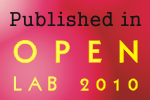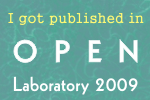TL; DR: The genome sequence of the North American Wood Frog will tell us a lot about the genetic control of freezing and reanimating whole organisms. My friend and colleague, Dr. Andor Kiss is crowdfunding this project. If you would like to help, please go to experiment.com. You will get acknowledged by name in the paper. To […]
So you received your mate-paired reads in two different files, and you need to merge them for your assembler. Here is a quick Python script to do that. You will need Biopython installed. #!/usr/bin/env python from Bio import SeqIO import itertools import sys import os # Copyright(C) 2011 Iddo Friedberg # Released under Biopython […]
Springville University’s Genome Center in collaboration with Prof. I. M. A. Bigschotte from IvyLeague University have announced that the genome of Mr. John Smith from Centertown, USA has been sequenced and is now available online. Dr. James Williams, director of the Center said: “We were running out of things to sequence, but I still had […]
Geek alert: this post for coders. So you sequenced your genome, reached an optimally small number of contigs, they look sane, and now you would like to see what you need for the finishing stage. Namely, how many gaps you have and what are their sizes. UPDATE: “might just be worth clarifying this is for […]
Yes! Why should the evolution people have all the fun with their blog carnival? (After all, it is only a theory.) It’s time for bioinformaticians to show what we are made of, and to have a carnival of our own. Bio::blogs had a good run some time ago. I decided to reconnect what is hopefully […]
<RANT> OK, I don’t like the term “next generation sequencing”. It is a relative term, points at a changing target, and therefore inexact. What is the “this-generation sequencing”? Sanger? 454 used to be “next generation”, but now 454 sequencing went from 100bp to 600bp per read, making it qualitatively different.. so “post-next generation sequencing”? If […]





